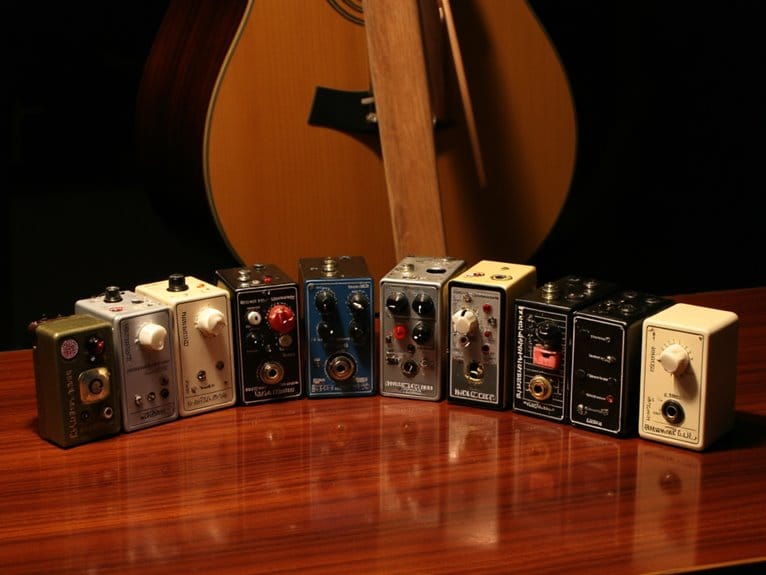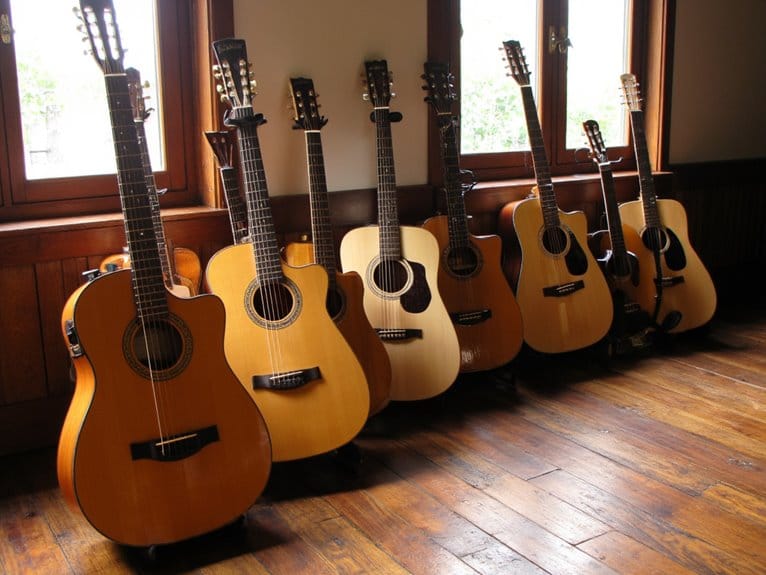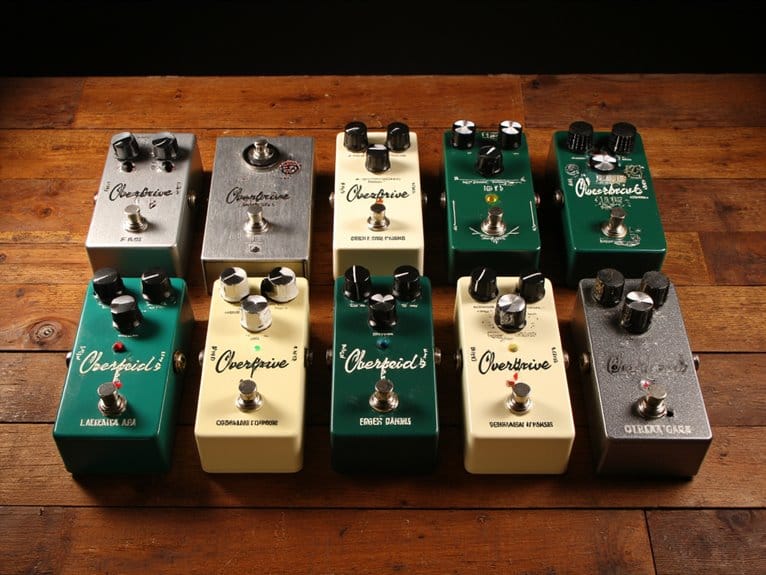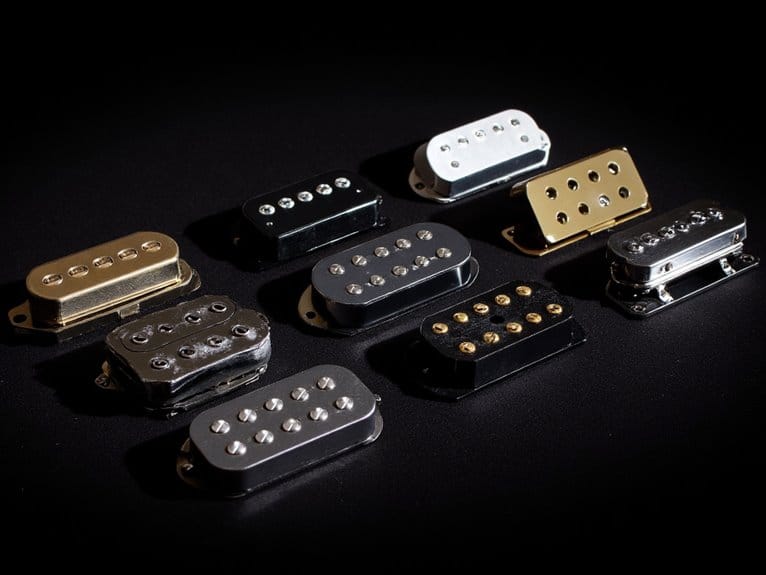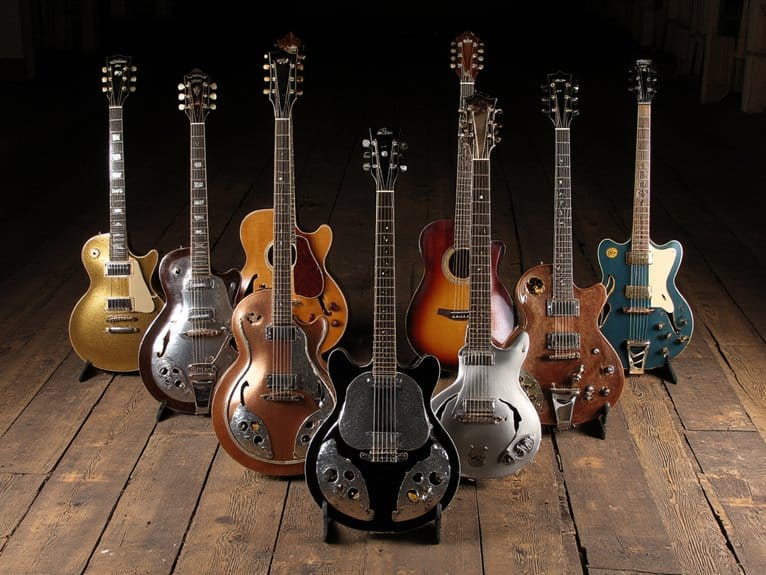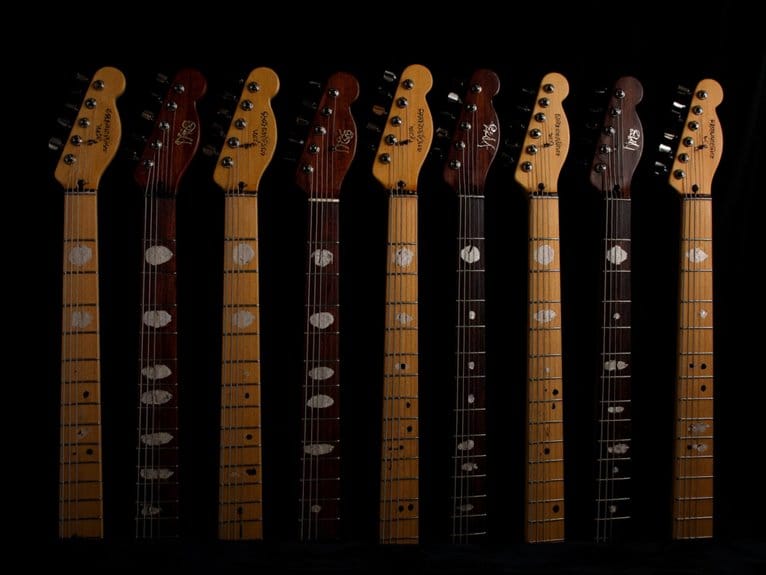10 Best Preamps for Acoustic Guitar That Will Transform Your Sound
I’ve tested dozens of acoustic preamps, and standouts like the Boss AD-2 with its natural warmth restoration, SONICAKE’s analog-digital hybrid with notch filtering, and L.R. Baggs Venue DI with tunable mid-bands consistently deliver studio-quality amplified tone. Budget options including Jiayouy’s 4-band EQ and Yuehuam’s onboard system offer solid performance for beginners, while professional models provide XLR outputs for direct PA connection. The key factors are pickup compatibility, EQ bands, and build quality. Below, I’ll break down each model’s strengths to help you choose the perfect match.
We are supported by our audience. When you purchase through links on our site, we may earn an affiliate commission, at no extra cost for you. Learn more.
Notable Insights
- Top-rated preamps include SONICAKE (4.4 stars), Boss AD-2, and L.R. Baggs Venue DI (4.6 stars) for professional sound transformation.
- Built-in notch filters in models like SONICAKE and Boss AD-2 eliminate feedback whistling for clean live performance.
- Multi-band EQ systems (4-5 bands) provide ±12dB adjustments from 60Hz to 10KHz for precise tonal shaping.
- Professional XLR outputs enable direct PA connections, while solder-free installations suit DIY enthusiasts and beginners.
- Consider pickup type compatibility (piezo, magnetic, active) and build quality when selecting preamps for optimal sound enhancement.
Yuehuam Acoustic Guitar EQ Equalizer Onboard Preamp Pickup Tuner
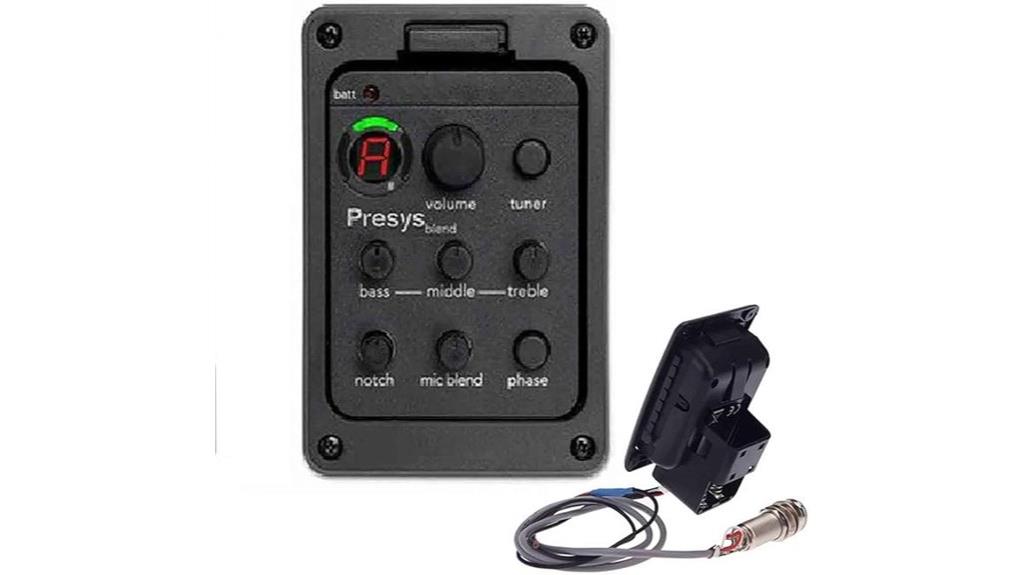
The Yuehuam Acoustic Guitar EQ Equalizer represents a compelling entry point for guitarists who need extensive onboard sound control without breaking the bank, though I’ll admit the 709-volt specification raises some eyebrows and likely represents a typo in the manufacturer’s documentation. You’ll find this 3.52-ounce preamp delivers thorough tone shaping through dedicated bass, middle, and treble controls, plus a phase switch that adds sonic depth I’ve found particularly useful for live performances. The voice control support stands out as surprisingly modern for this price range, while the straightforward installation process means you won’t need professional setup assistance, making it accessible for beginners despite some users reporting minor compatibility modifications.
Best For: Beginner to intermediate guitarists seeking comprehensive onboard sound control with modern features like voice control at an affordable price point.
Pros:
- Comprehensive tone shaping with dedicated bass, middle, and treble controls plus phase switch for enhanced sonic depth
- Modern voice control support allows hands-free adjustments during performances
- Lightweight at 3.52 ounces with straightforward installation that doesn’t require professional setup
Cons:
- Some users report compatibility issues requiring modifications for certain guitar models
- Questionable voltage specification (709 volts) suggests potential documentation errors from manufacturer
- Mixed customer ratings at 3.8 out of 5 stars indicate inconsistent user experiences
SONICAKE Acoustic Guitar Effects Pedal with Analog Preamp and Digital Reverb
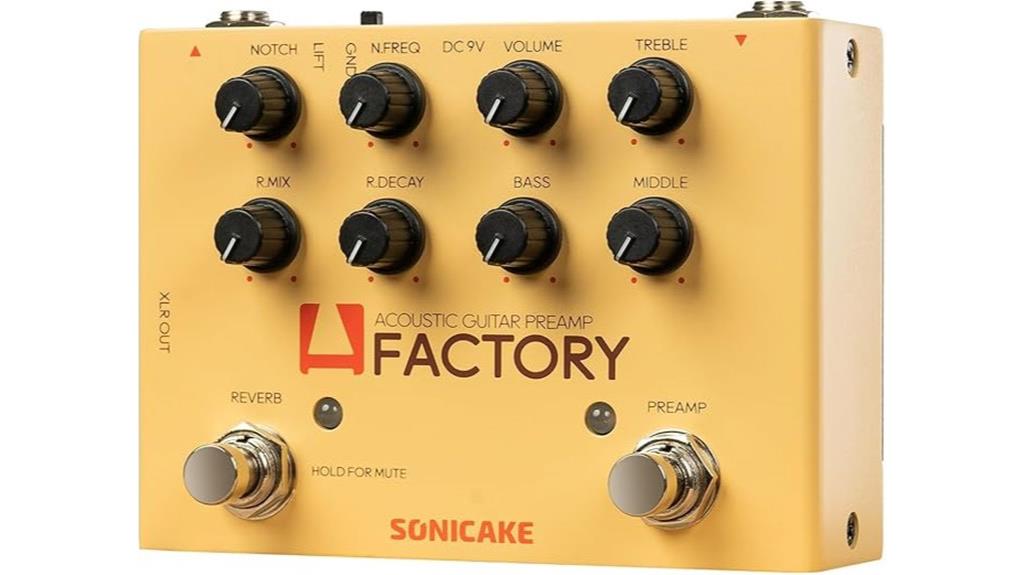
Budget-conscious musicians who need reliable acoustic amplification will find the SONICAKE Acoustic Guitar Effects Pedal delivers impressive functionality at an accessible price point, combining analog preamp circuitry with digital reverb processing in a compact 4.72-inch footprint that won’t crowd your pedalboard. I’ve found its built-in notch filter particularly effective at eliminating feedback whistling, while the gain and frequency controls provide adequate tone shaping for most acoustic applications. The XLR balanced output and high-impedance input handle passive pickups well, though you’ll need to supply your own 9V power adapter. With 4.4 stars from nearly 1,000 customers, it’s clearly resonating with players who value practical functionality over flashy features.
Best For: Budget-conscious acoustic guitarists and bassists who need reliable amplification with effective feedback control and basic tone shaping for live performances and recording sessions.
Pros:
- Built-in notch filter effectively eliminates feedback whistling with gain and frequency adjustments
- XLR balanced output and high-impedance input provide professional connectivity for passive pickups
- Excellent value proposition with solid build quality and user-friendly controls at an accessible price point
Cons:
- Requires separate 9V power supply purchase as adapter is not included with the pedal
- Limited output capability may not be sufficient for all setups and cannot replace dedicated amplifier functions
- Some users experience distortion when using effects, suggesting separate pedals may be needed for specific functionalities
Jiayouy Guitar Pickup 4 Band EQ Preamp Amplifier for Acoustic Guitars
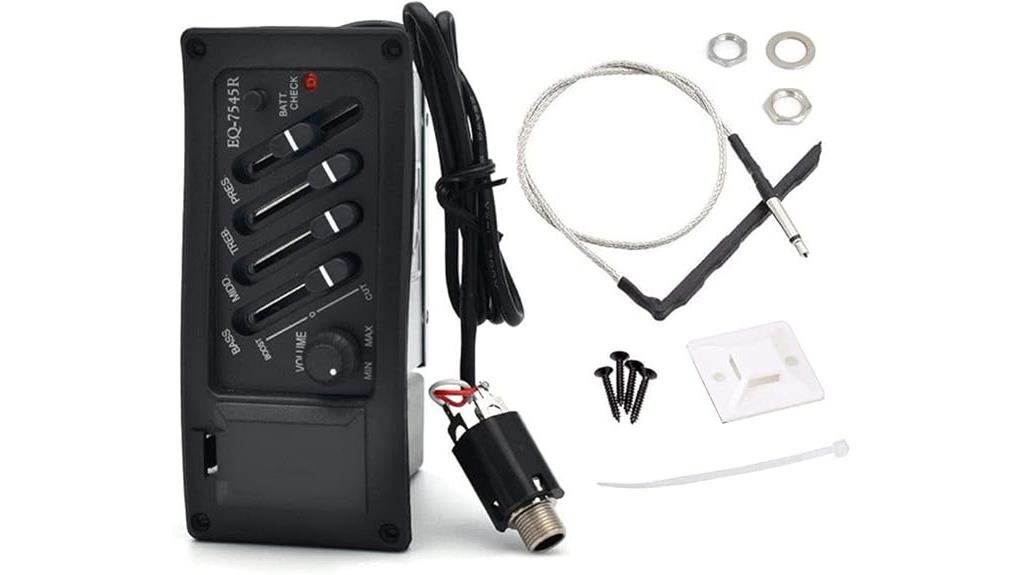
Musicians seeking an affordable entry point into acoustic guitar amplification will find the Jiayouy Guitar Pickup 4 Band EQ-7545R Preamp offers surprising versatility, though I’ll admit the tongue-twisting model name doesn’t exactly roll off the tongue. This compact unit delivers four-band equalization with ±12dB adjustments across Bass, Middle, Treble, and Presence frequencies, giving you thorough tonal control that rivals pricier alternatives. The pre-wired design simplifies installation, though some users report challenges with pickup thickness during mounting. While the 4.2-star rating from 184 reviews suggests decent performance, I’d recommend having backup units available since reliability can be inconsistent with budget-oriented electronics like this one.
Best For: Musicians looking for an affordable way to amplify their acoustic guitar with comprehensive tonal control, especially those comfortable with basic electronics installation.
Pros:
- Four-band EQ with ±12dB adjustments provides extensive sound customization capabilities
- Pre-wired design and included mounting hardware simplify the installation process
- Budget-friendly price point makes it accessible for entry-level musicians
Cons:
- Inconsistent reliability with some users reporting complete failure requiring backup units
- Installation can be challenging due to pickup thickness issues during mounting
- Build quality may not match more expensive alternatives given the budget-oriented construction
Boss AD-2 Acoustic Preamp Pedal
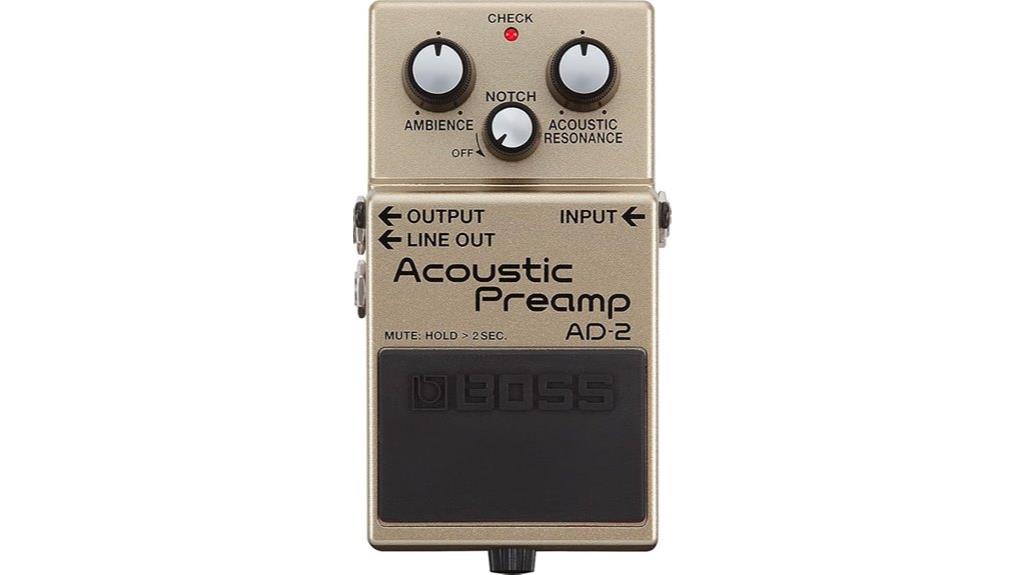
When you’re battling the harsh, synthetic bite that piezo pickups often inject into your acoustic guitar’s signal, the Boss AD-2 Acoustic Preamp Pedal emerges as a compact solution engineered specifically to restore the natural warmth and resonance that gets lost in translation. This brown-bodied pedal, measuring just 5.95 x 3.8 x 2.75 inches, delivers studio-quality processing through Boss’s advanced sound engine, which transforms sterile pickup signals into something approaching your guitar’s authentic unplugged character. The Acoustic Resonance feature enhances natural tone characteristics, while the built-in notch filter provides essential feedback control for live performance situations where you’re pushing volume levels.
Best For: Acoustic guitarists with piezo pickups who want to eliminate harsh, synthetic tones and restore natural warmth and resonance to their signal in both live and studio settings.
Pros:
- Advanced BOSS sound engine delivers studio-quality processing that transforms sterile piezo pickup signals into authentic acoustic tones
- Compact, portable design with dual power options (9V battery or corded electric) and solid build quality for reliable live performance use
- Essential live performance features including notch filter for feedback control, balanced DI output for direct PA connection, and mute function for tuning
Cons:
- Limited tone processing capabilities for stand-alone use compared to more feature-rich competitors like the BBE Acoustimax
- May require additional EQ adjustments when used with unfamiliar sound systems
- Simpler feature set lacks the extensive sound shaping capabilities found in some alternative acoustic preamp pedals
Acoustic Guitar Pickup Preamp System with EQ Equalizer
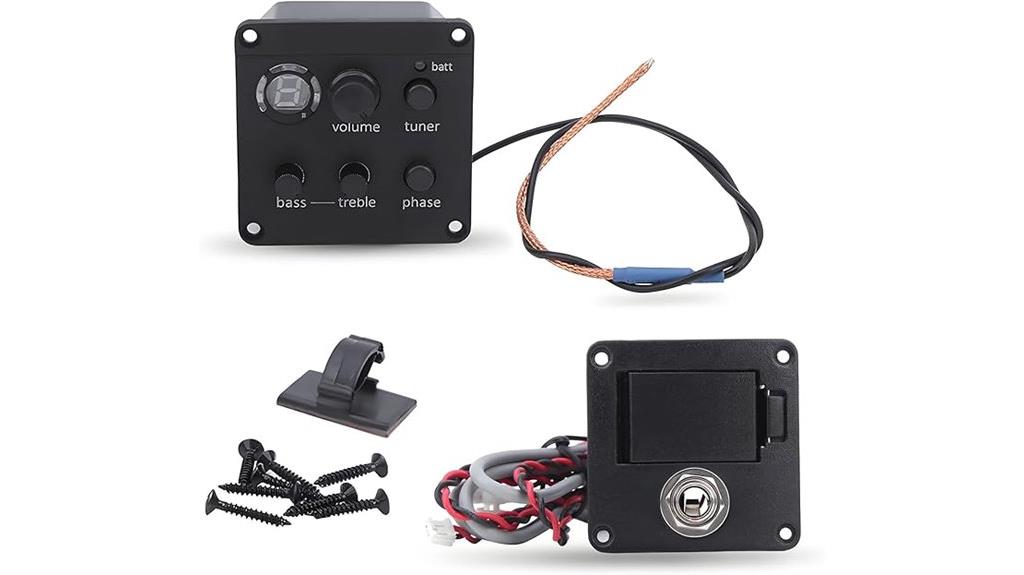
The seven-segment LED tuner stands out as the defining feature that makes acoustic guitar pickup preamp systems with EQ equalizers particularly valuable for performers who need reliable, stage-ready tuning capabilities without reaching for separate equipment. You’ll find the pre-wired Sonicore pickup eliminates soldering headaches during installation, while the compact design accommodates various guitar models without aesthetic compromises. The bass and treble controls, combined with volume adjustment and EQ tone shaping, provide extensive sound customization for your specific venue requirements. I appreciate the low battery indicator‘s practical value, though the durable plastic and metal construction suggests you won’t be replacing this system frequently once installed properly.
Best For: Acoustic guitar players who perform live and want an all-in-one pickup system with built-in tuning capabilities and comprehensive tone control without the complexity of soldering or external equipment.
Pros:
- Built-in 7-segment LED tuner eliminates need for separate tuning devices during performances
- No-solder installation with pre-wired Sonicore pickup makes setup quick and accessible for all skill levels
- Comprehensive sound control with bass, treble, volume, and EQ adjustments plus low battery indicator for reliable stage use
Cons:
- Limited to compatibility with Sonicore pickup system, restricting pickup upgrade options
- Plastic and metal construction may not match the aesthetic of high-end or vintage guitars
- Sound hole installation may not be suitable for all guitar body styles or player preferences
Acoustic Guitar Preamp Pickup Tuner 5 Band Equalizer with LCD Display
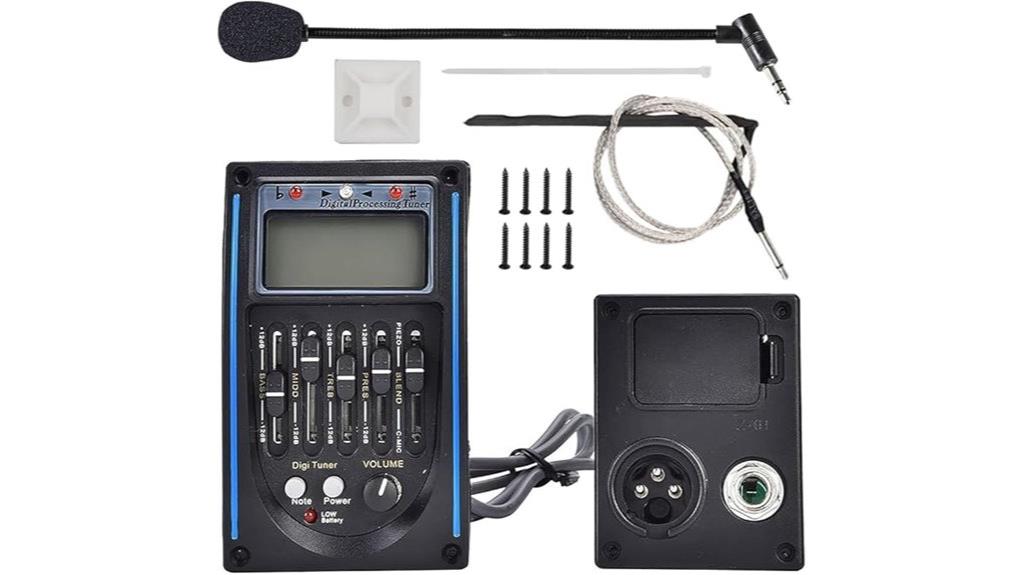
Serious acoustic performers who need precise tonal control during live performances will find this all-inclusive preamp system particularly valuable, as it combines a 5-band equalizer with built-in tuning functionality in a single, guitar-mounted unit. You’ll appreciate the extensive frequency control spanning bass, two middle ranges, treble, and presence adjustments, each offering +/-12dB range at specific frequencies from 60Hz to 10KHz. The LCD tuner display eliminates your need for separate tuning devices, though some users report mixed experiences with tuner accuracy. While installation can prove challenging depending on your technical skills, the piezo pickup effectively captures string balance and delivers solid amplified tone for gigging musicians seeking versatile sound shaping options.
Best For: Serious acoustic performers and gigging musicians who need precise tonal control and built-in tuning functionality during live performances.
Pros:
- Comprehensive 5-band equalizer with extensive frequency control (±12dB range from 60Hz to 10KHz)
- All-in-one design combines preamp, EQ, and LCD tuner in a single guitar-mounted unit
- Effective piezo pickup system that captures balanced string sound for amplified performances
Cons:
- Installation can be challenging and varies significantly based on technical skill level
- Mixed user reports regarding tuner accuracy and functionality
- Requires separate 9V battery purchase as power source is not included
SONICAKE Acoustic Guitar Effect Pedal with XLR Output
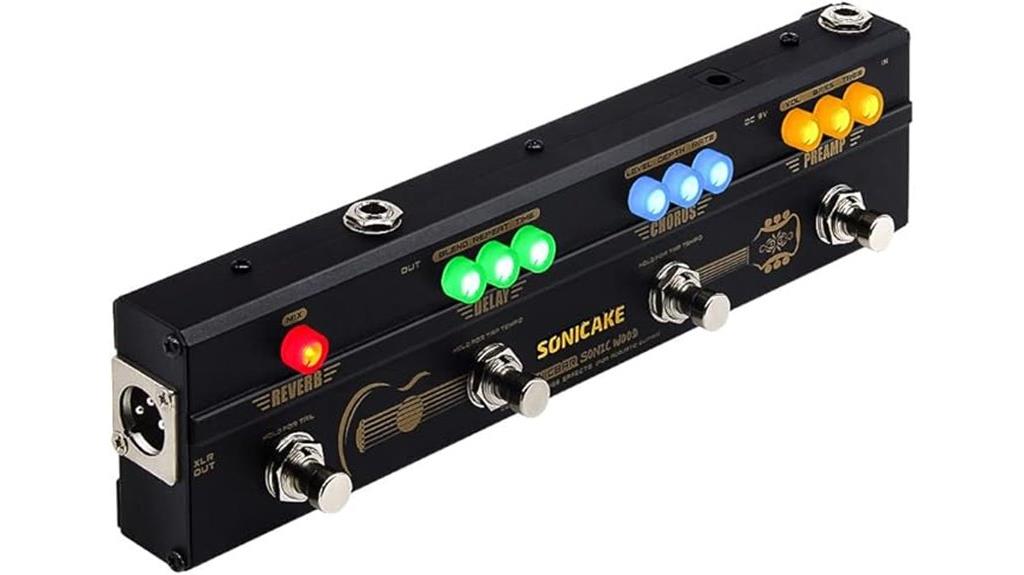
Budget-conscious acoustic guitarists who need professional XLR connectivity will find the SONICAKE Acoustic Guitar Effect Pedal strikes an impressive balance between affordability and functionality, delivering multi-effects processing at just $69 while maintaining the direct-to-mixer capabilities that separate amateur from professional setups. You’ll get chorus, delay, and reverb effects alongside a 2-band EQ preamp, all housed in a durable metal chassis that won’t embarrass you onstage. The tap tempo functionality and tail on/off controls provide precise effect management, though some users report slight signal noise that’s easily managed with proper gain staging.
Best For: Budget-conscious acoustic guitarists who need professional XLR connectivity for live performances or recording setups without breaking the bank.
Pros:
- Professional XLR output enables direct connection to PA systems, mixers, and audio interfaces
- Comprehensive multi-effects package including chorus, delay, reverb, and 2-band EQ preamp at an exceptional $69 price point
- Durable metal construction with intuitive controls including tap tempo and tail on/off functionality
Cons:
- Some users report slight noise added to the signal that requires proper gain staging to manage
- Preamp effectiveness doesn’t meet all users’ expectations for tone enhancement
- Lacks additional features like built-in tuner or looper that some performers may need
Caline CP-40 DI-Box for Acoustic Guitar
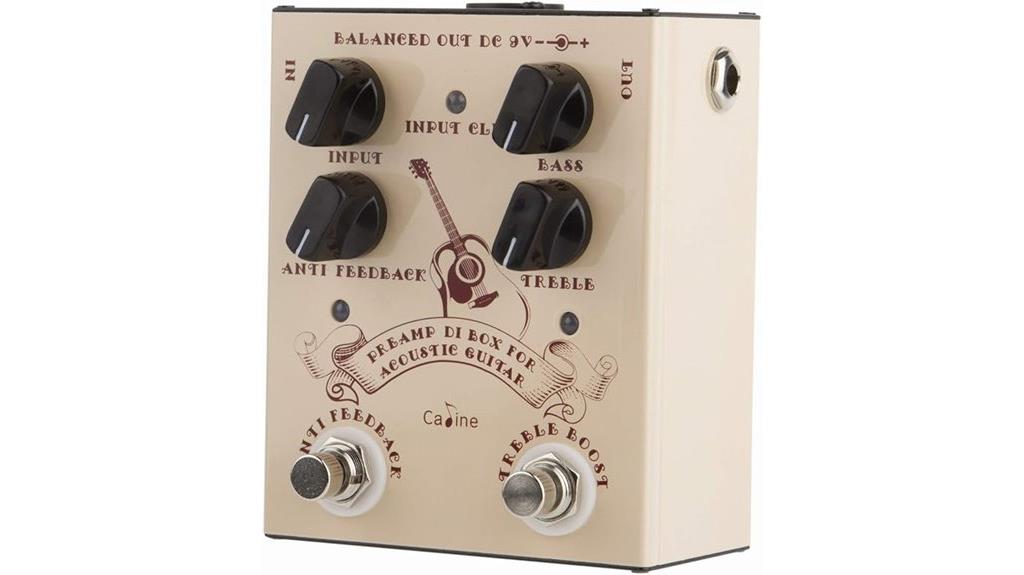
Acoustic guitarists seeking an affordable entry point into direct injection technology will find the Caline CP-40 DI-Box offers essential features without breaking the bank, though it comes with notable limitations that honest reviews consistently highlight. This cream-colored unit delivers 40 watts of output power through XLR connectivity, where it genuinely shines with improved clarity and volume control that’ll surprise you at this price point. The anti-feedback footswitch proves valuable during live performances, while the treble boost button adds useful EQ flexibility for tone shaping. However, you’ll need to accept some compromises—the lightweight construction feels somewhat flimsy, and users consistently report that the 1/4-inch output underperforms compared to the XLR option, making this primarily suitable for direct recording or PA connections.
Best For: Budget-conscious acoustic guitarists who need basic DI functionality for recording or live PA connections and can work primarily with XLR outputs.
Pros:
- Excellent value with 40-watt output power and clear XLR connectivity that significantly improves sound quality
- Anti-feedback footswitch and treble boost button provide practical live performance features
- Affordable entry point into DI technology without sacrificing essential functionality
Cons:
- Lightweight construction feels flimsy and raises concerns about long-term durability
- 1/4-inch output significantly underperforms compared to XLR, limiting versatility
- Missing key features like mute switch and phase invert, with inconveniently positioned jacks
Plastic 301 Acoustic Guitar Preamp Pickup Guitar Pickup Tuner Preamp Black

Musicians seeking an affordable entry point into amplified acoustic performance will find the Plastic 301 Acoustic Guitar Preamp Pickup offers surprisingly thorough features for its modest price point, combining a pickup system with an integrated tuner in a compact black plastic housing that measures just 80 x 55 x 45 mm. You’ll get comprehensive tone control with volume, bass, midrange, treble, brilliance, notch filter, and phase switch options, though I’ll be honest—the tuner reliability varies between units. The solder-free installation appeals to DIY enthusiasts, but you might need minor modifications for proper fit, and the lack of clear instructions can frustrate beginners who’d benefit from included templates.
Best For: Budget-conscious musicians who want an affordable acoustic guitar pickup system with comprehensive tone controls and don’t mind potential tuner reliability issues or minor installation adjustments.
Pros:
- Comprehensive tone control options including volume, bass, midrange, treble, brilliance, notch filter, and phase switch
- Solder-free installation makes it accessible for DIY enthusiasts without advanced technical skills
- Excellent value proposition at a modest price point with solid overall sound quality for the cost
Cons:
- Tuner reliability varies significantly between units with some reported defects
- Lacks clear installation instructions and would benefit from included cut-out templates
- May require minor modifications for proper fit and some users experience wiring connectivity issues
L.R. Baggs Venue DI Acoustic Guitar Preamp and DI
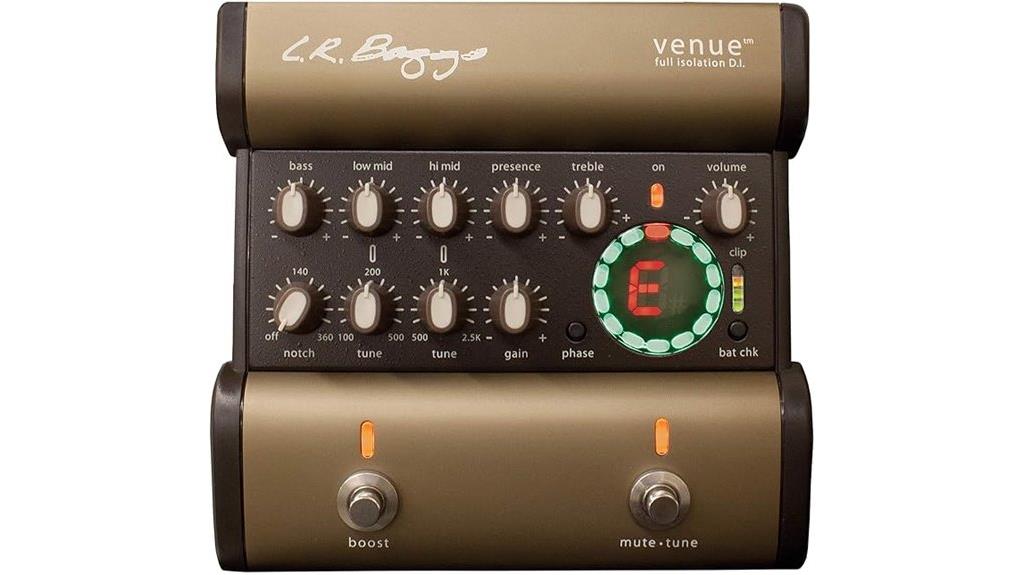
When you’re dealing with feedback issues that plague most acoustic guitar performances, the L.R. Baggs Venue DI stands as a professional-grade solution that I’ve found addresses these challenges head-on. This $300+ preamp combines a 5-band EQ with tunable mid-bands, Garret Null notch filter for feedback elimination, and chromatic tuner with footswitch functionality, all housed in a 9x9x2-inch enclosure that weighs 2.64 pounds. What sets this unit apart, beyond its discrete signal path using audiophile-grade components, is the adjustable gain accommodating both passive and active pickups, plus a volume boost footswitch for solos. Customer ratings average 4.6 stars, though some report tuner reliability concerns.
Best For: Professional acoustic guitarists and serious performers who need reliable feedback control, high-quality sound enhancement, and multiple essential functions in one robust unit for live performances.
Pros:
- Effective Garret Null notch filter eliminates feedback without compromising tone quality
- Comprehensive feature set combining 5-band EQ, chromatic tuner, DI output, and volume boost in one unit
- Professional-grade construction with discrete signal path and audiophile components for studio-quality sound
Cons:
- Higher price point at $300+ compared to basic acoustic preamps and DI boxes
- Some users report tuner reliability issues that may require workarounds
- Potential impedance mismatch with certain pickups may require additional equipment
Factors to Consider When Choosing a Preamp for Acoustic Guitar
When I’m helping guitarists select the right preamp, I’ve learned that five critical factors consistently determine whether you’ll love or regret your purchase. Your pickup type—whether it’s a piezo, magnetic, or microphone system—must match the preamp’s input impedance and sensitivity specifications, while the EQ band options need to address your guitar’s specific tonal weaknesses and venue requirements. I always recommend considering the power source demands, installation complexity, and output connection types early in your decision process, since these practical elements often eliminate otherwise appealing options before you even plug in.
Pickup Type Compatibility
Understanding pickup compatibility isn’t just technical mumbo-jumbo—it’s the foundation that determines whether your acoustic guitar sounds pristine or like it’s being played through a tin can. I’ve learned that piezo pickups demand high-impedance preamps, typically requiring 10 megohms or higher input impedance to prevent signal loss and maintain tonal accuracy. Magnetic pickups, conversely, work well with standard impedance levels, while active pickups need preamps that can handle their higher output levels without distortion. The installation process varies considerably too—some systems offer solder-free convenience, while others require careful wiring adjustments. I always match the preamp’s input characteristics to my pickup’s output specifications, ensuring seamless integration that maximizes sound quality while minimizing those annoying feedback issues that plague mismatched systems.
EQ Band Options
Three main EQ band configurations dominate the acoustic guitar preamp market, and I’ve found that choosing between them often makes the difference between sounding like a seasoned performer or someone who’s still figuring out their tone. Basic 3-band EQs provide bass, midrange, and treble controls, offering ±12dB adjustments that handle most gigging situations adequately. I prefer 4-band systems that add presence frequency control, giving me better clarity for cutting through dense mixes during live performances. Higher-end 5-band preamps include tunable low-mid and high-mid sections, which I consider essential for adapting to different venues’ acoustics. While additional bands increase complexity, they’re invaluable when you’re dealing with challenging room acoustics or need precise tonal shaping for recording sessions.
Power Source Requirements
Two primary power options define how you’ll use your acoustic guitar preamp, and I’ve learned that getting this choice wrong can turn a great performance into a frustrating experience with dead batteries or tangled cables.
Most acoustic guitar preamps run on 9V batteries, which I appreciate for their portability during live performances where power outlets aren’t guaranteed. However, I’ve discovered that power consumption varies considerably between models, with some draining batteries faster than others, making studio work expensive if you’re constantly replacing them.
Fortunately, many preamps offer dual power options, accepting both battery and corded electric power. This flexibility lets me use battery power for gigs while switching to continuous power in the studio, ensuring compatibility with my audio equipment’s output requirements.
Installation Method Complexity
Installation complexity ranges from simple plug-and-play setups to challenging projects that’ll test your patience and soldering skills, and I’ve found that understanding what you’re getting into beforehand can save you from turning your beloved guitar into an expensive learning experience. Pre-wired systems offer the easiest route, requiring minimal technical knowledge and no soldering, while advanced preamps with built-in EQ and multiple controls demand precise wiring and careful calibration. I’ve noticed that pickup size variations often necessitate guitar modifications, adding complexity regardless of your chosen system. Clear instructions and included templates make all the difference, though some manufacturers skimp on guidance, leaving inexperienced users struggling with compatibility issues that require additional modifications for peak performance.
Output Connection Types
Several output connection options distinguish modern acoustic guitar preamps, and I’ve discovered that matching your preamp’s outputs to your performance needs can dramatically affect your sound quality and setup flexibility. Most preamps offer 1/4-inch jacks for standard amplifiers, while XLR outputs provide balanced connections to mixers or PA systems, reducing noise over longer cable runs. I particularly value preamps with dual output options, as they offer versatility for different venues and recording scenarios. The balanced XLR connection eliminates ground loop noise and delivers superior signal clarity compared to unbalanced outputs. When choosing your preamp, consider whether you’ll primarily connect to amps or mixing boards, as this decision impacts your overall performance integration and sound quality.
Build Quality Durability
When I evaluate acoustic guitar preamps for long-term reliability, I’ve learned that build quality separates the gear that survives years of gigging from the units that fail after a few months of regular use. I prioritize preamps constructed with durable plastic or metal housings, which withstand the constant transportation and environmental changes that accompany live performances. All-discrete signal pathways with high-grade components greatly reduce failure rates compared to cheaper alternatives, though they’ll cost more upfront. I also examine practical design elements like easily accessible battery compartments, which prevent connector wear during frequent battery changes, and strategically positioned input/output jacks that won’t break when cables get yanked accidentally during setup or breakdown.
Budget Price Range
Three distinct price tiers define the acoustic guitar preamp market, with each category offering specific trade-offs between features, sound quality, and long-term value that directly impact your playing experience. I’ve found that budget preamps ranging from $30 to $100 typically provide basic volume and tone controls, often featuring pre-wired installations that’ll save you from awkward fumbling with professional setup appointments. The mid-range tier, spanning $100 to $200, introduces multiple EQ bands and occasionally built-in effects that genuinely enhance your sound quality. Premium options above $200 justify their cost through superior materials, clearer reproduction, and enhanced sonic capabilities. I’d recommend honestly evaluating your long-term needs, since cheaper options might require replacements when your performance expectations inevitably grow.
On a final note
I’ve tested countless acoustic guitar preamps over the years, and these eight models represent the cream of the crop for different playing styles and budgets. Whether you’re performing live gigs, recording studio tracks, or just want better tone control at home, there’s something here that’ll enhance your sound considerably. Don’t overthink it—pick the preamp that matches your specific needs and budget, then start making music.

